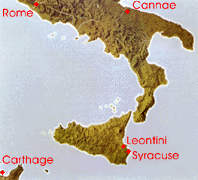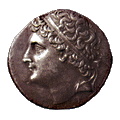Historical Interlude
 At the beginning of the third century
BC, the Mediterranean basin was controlled by the Carthaginians in the west and the Greeks in the east.
The Romans controlled only a small area around Rome, but were poised to march.
They locked horns with Carthage in the First Punic War (264-241
BC), during which they greatly expanded their territory, although they did not capture the city of Carthage itself.
The Greek city of Syracuse, where Archimedes lived, initially supported Carthage.
But early in the war Rome forced a treaty of alliance from Syracuse's king,
Hiero II, that called for Syracuse to pay tribute and provide grain to the Romans.
At the beginning of the third century
BC, the Mediterranean basin was controlled by the Carthaginians in the west and the Greeks in the east.
The Romans controlled only a small area around Rome, but were poised to march.
They locked horns with Carthage in the First Punic War (264-241
BC), during which they greatly expanded their territory, although they did not capture the city of Carthage itself.
The Greek city of Syracuse, where Archimedes lived, initially supported Carthage.
But early in the war Rome forced a treaty of alliance from Syracuse's king,
Hiero II, that called for Syracuse to pay tribute and provide grain to the Romans.


Marcellus and Hiero II
The Second Punic War began in 218 BC. Hannibal crossed
the Alps into Italy (218 BC) and defeated of the Romans at Cannae (216 BC).
Hannibal's successes in Italy helped convince many Syracusans that they were allied with the wrong side.
Hiero II honored his treaty with Rome while he lived. However, upon his death in 215
BC he was succeeded by his
15-year-old grandson Hieronymos who began negotiations with Hannibal.
Hiernoymos was assassinated in 214 BC, leading to civil war in Syracuse between the pro-Carthaginian and pro-Roman
factions. The pro-Carthaginian faction was eventually victorious.
The Romans sent Marcus Claudius Marcellus to Sicily to deal with the situation.
Marcellus besieged Syracuse in 213 BC. He attacked the coastal walls of Syracuse with sixty quinqueremes (battleships with five-man oar banks) while his
co-commander attacked the inland walls with ground troops.
End of the Historical Interlude
-
Archimedes played an important role in the defense of Syracuse against the
siege laid by the Romans in 213 BC by constructing war machines so effective that they long delayed the capture of the
city.
-
He was killed when Syracuse was eventually captured by the Marcellus in the autumn of 212 or spring of 211
BC.
back | next | index
 At the beginning of the third century
BC, the Mediterranean basin was controlled by the Carthaginians in the west and the Greeks in the east.
The Romans controlled only a small area around Rome, but were poised to march.
They locked horns with Carthage in the First Punic War (264-241
BC), during which they greatly expanded their territory, although they did not capture the city of Carthage itself.
The Greek city of Syracuse, where Archimedes lived, initially supported Carthage.
But early in the war Rome forced a treaty of alliance from Syracuse's king,
Hiero II, that called for Syracuse to pay tribute and provide grain to the Romans.
At the beginning of the third century
BC, the Mediterranean basin was controlled by the Carthaginians in the west and the Greeks in the east.
The Romans controlled only a small area around Rome, but were poised to march.
They locked horns with Carthage in the First Punic War (264-241
BC), during which they greatly expanded their territory, although they did not capture the city of Carthage itself.
The Greek city of Syracuse, where Archimedes lived, initially supported Carthage.
But early in the war Rome forced a treaty of alliance from Syracuse's king,
Hiero II, that called for Syracuse to pay tribute and provide grain to the Romans.

